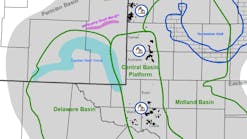Polymer treatment isolates depleted zone, enabling untapped-zone production
A polymer treatment isolated a watered-out zone and enabled production from a lower, previously untapped zone in a Gulf of Mexico (GOM) well, operated by Marathon Oil Co.
Marathon estimates that the cost of the work (Figs. 1a-1d), performed rigless and through coiled tubing, was about 35% of the cost for a workover rig recompletion.
On a 12/64-in. choke, initial gas production from the newly activated zone was 1.7 MMscfd and 38 b/d of condensate, with no sand or water production. After an increase in choke size to 14/64 in., the well has continued to produce water and sand-free at about 2.3 MMscfd and 16 b/d of condensate for 1 year.
Polymer water block
The polymer water-block (PWB) system is a permeability blocker injected into the formation matrix.
The injected PWB is initially a low-viscosity liquid that extends 1-3 ft past the perforated casing. After setting, the PWB becomes a very stable, permanent gel.
When properly placed, the PWB penetrates the formation and blocks permeability, stopping unwanted production. The liquid components of the PWB allow it to be mixed and prepared simply.
The system includes a high temperature, base-polymer sealant and an organic crosslinker.
The base polymer is a low-molecular-weight acrylamide copolymer with enhanced thermal stability that forms strong covalent bonds with the system's organic crosslinker.
Both components are in solutions that can be diluted as needed, thereby allowing for either batch mixed or blended formulations.
The two blended components are placed as a single, low-viscosity fluid (3-35 cp) that forms a solid gel at bottomhole temperatures.
Features of the system include:
- Penetration up to 30 ft into formation.
- Application temperature range of 125-325° F.
- Liquid system for ease of mixing.
- Predictable reaction rates.
- Formulations designed for each job.
- Self-diverting system, enabling treatment of long intervals.
- Extremely rigid when set, resisting up to 2,500-psi differential pressure.
Running the job
The Marathon well originally was perforated and gravel packed across 102 ft of sand.
The lower unperforated sand was just below the gravel-pack assembly but below the end of tubing. Under these conditions, an operator would typically use a workover rig to remove the old gravel-pack installation before completing the well across the unperforated zone.
Marathon, instead, elected to use the PWB system to plug the watered-out zone and to use coiled tubing to access the lower zone.
Fig. 1a shows the well prior to the recompletion. The upper gravel-packed zone produced for 18 years before watering out, but the lower zone was not mechanically set up for a recompletion.
The job pumped the PWB through coiled tubing (Fig. 1b), using the hesitation squeeze application technique. Pumping began at the bottom of the zone, after which the treating crew pulled the coiled tubing up a few feet and pumped more PWB.
This sequence continued until all sealant had been injected across the entire interval.
After the sealant set up for 48 hr, the crew washed the PWB out of the production tubing and pressure tested the seal for integrity (1,000 psi differential without leaking off).
The crew repeated the hesitation squeeze application, waited for polymer setup, and integrity-tested twice before a successful test of the polymer plug back (Fig. 1c).
Once the polymer plug back held, the crew set a plug and then dumped lead shot and cement to create a new top of cement (Fig. 1d).
The next step in the job perforated a 20-ft interval at 12 shots/ft and set a vent screen on the top of cement. This was followed by an acid job for stimulating the well and placement of liquid sand to provide sand control. After cleanup, Marathon placed the well on production. The well continues to produce strongly after more than 1 year on line.
A summary of the steps in the job is as follows:
- Secure regulatory agency approvals.
- Make up bottomhole assembly on coiled tubing.
- Run in hole and circulate one hole volume out.
- Test injectivity with 8.6-ppg seawater.
- Pump 50 bbl PWB, using hesitation-squeeze method.
- Let PWB set for 48 hr, then pressure-test plug to 1,000 psi at the surface.
- Wash excess PWB out of the tubing, leaving PWB in formation pore spaces.
- Pressure test plug to 1,000 psi at the surface.
- Displace 8.6-ppg seawater with 10.1-ppg calcium chloride until fluid weight stabilizes.
- Set a plug below the zone to be completed. Use a bailer to dump lead shot and cement until a new top of cement forms at a predetermined measured depth.
- Make up 20-ft perforating gun and perforate (overbalanced) the new producing zone at 12 shots/ft. Keep the hole full of 10.1-ppg CaCl2.
- Run the vent screen assembly into the hole while circulating well fluid.
- Pump acid and gravel-pack liquid sand through coiled tubing. Use 1,000 psi squeeze pressure maximum unless surface pressure tests higher.
- Pump to screenout, then circulate excess slurry until clean.
- Replace CaCl2 water with 8.6-ppg seawater.
- Wash excess proppant out.
- Produce the well following preplanned procedures.
The authors
John Warren (John.Warren@ halliburton.com) is a commercialization manager for near-wellbore stimulation projects for Halliburton. While at Halliburton, he has worked as a field engineer, operations engineer, and account representative. Warren has a BS in mechanical engineering from Colorado State University.
Tara West (tmwest@ marathonoil.com) is a reservoir engineer for Marathon Oil Co. in Houston. She previously worked for Marathon as a reservoir-production engineer in Lafayette, La. West holds a BS in petroleum engineering from the Colorado School of Mines.



